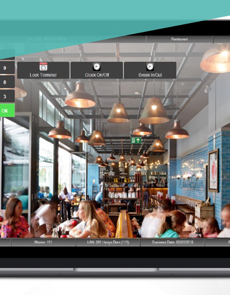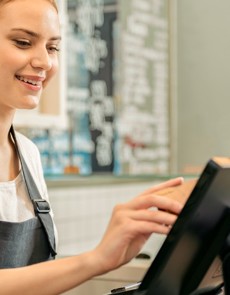How much does a restaurant PoS system cost
If you’re a restaurant owner or manager, you may be wondering how much it costs to implement a new point of sale system across your business.
There are a lot of factors that influence the cost of a POS system, including the necessary hardware (if required), license fees, processing fees, support and service fees and implementation costs. As a leading supplier of EPoS systems to hospitality businesses, we understand the importance of finding the right system at the right price.
We’ve pulled together some of our product specialists to delve into what a POS system does and how to determine the ROI of your chosen system, including a breakdown of the costs of some of the leading options in the UK, so you can make an informed decision.
By the end of this article, you’ll have a better understanding of how much you can expect to spend on a POS system, and what factors to consider when making this investment.
What to consider when budgeting for a POS system
When it comes to choosing a POS system for your restaurant, there are a multitude of factors to consider. It's important to keep in mind the unique needs and demands of the hospitality industry, which is distinct from other retail sectors due to its emphasis on customer service, time pressures, and service being concentrated around specific times of the day.
Additionally, the working environment of a restaurant puts added strain on a POS system, making it crucial to select one that is up to the task. In this section, we'll explore what you need to consider when budgeting for a POS system, so you can find a solution that not only fits your budget but also meets the specific requirements of your restaurant.
Here are some things you should consider when budgeting for a POS system:
What hardware will I need?
One essential part of installing a POS is the hardware any system will need. Some platforms might be able to integrate with your existing hardware, while others might need you to upgrade to their proprietary hardware. While your business will have it specific needs specific items to consider include:
Terminal
This is the main hardware component of the POS system, and it typically is where restaurant staff input orders, process payments, and perform other POS functions. These days, a lot of terminals are handheld to allow staff to process orders at table, though there may still be a standalone terminal at the reception desk which marries up with the cash drawer. A handheld unit can offer suggestions such as wine matching or upselling opportunities as the server progresses through the order process.
Cash drawer
A cash drawer necessary for handling cash transactions. The cash drawer can be configured to open automatically when a transaction is processed and the contents monitored for easy reconciliation.
Kitchen display system
Orders can be sent quickly and easily to the kitchen where orders will appear in time order, or can be reordered to accommodate special requests or circumstances, such as special dishes that take a long time to prepare. The Access kitchen order management system runs in parallel with Access EPoS so that staff can view recipes and timings, delivering a consistent product.
Barcode/QR Code scanner
Scanners can be used to scan barcodes on products, coupons or loyalty cards. This can speed up the order process and reduce errors.
Card reader
A card reader is necessary for processing credit or debit card transactions. The card reader can be integrated with the system, and it can be either a chip and PIN or a magnetic stripe reader, as well as being configured for phones and watches.
Self-ordering terminal
These can include units within the restaurant or at table, or be a software integration that uses a QR code to allow customer’s own device to become part of the POS system.
The specific hardware items required for a restaurant EPoS will depend on the restaurant's specific needs and preferences. It's important to select high-quality hardware that is reliable and can handle a high volume of transactions especially clustered around busy periods.
What kind payment processing fees will be charged?
Payment processors manage the credit card transaction process by acting as the mediator between your business and the bank, and they charge a fee for doing so. Different payment providers may approach payment processing fees differently, depending on their business model and agreements with payment partners.
Flat fee
Some payment providers charge a flat fee per transaction, regardless of the transaction amount or payment method. This approach can be simple and easy to understand, but it may not be the most cost-effective for businesses that process many relatively small transactions.
Percentage fee
The majority of payment providers charge a percentage fee based on the transaction amount. The percentage fee may vary depending on the payment method used, with credit card payments typically carrying higher fees than debit card payments.
Tiered pricing
Some payment providers offer tiered pricing, with different fees for different transaction volumes or types of payments. For example, a service may charge a lower fee for small transactions and a higher fee for larger transactions.
Subscription-based
Some payment providers charge a subscription fee that includes payment processing, among other features. This approach can be beneficial for businesses that process a large volume of transactions and want a predictable, all-inclusive fee.
Custom rates
Some payment providers may negotiate custom rates with payment processors for their customers based on their business size, transaction volume, and other factors. This approach can be beneficial for businesses that process a high volume of transactions and want to minimise their payment-processing fees.
The approach to payment processing fees can vary depending on the EPoS service, so it's important for businesses to research and compare different options to find the best fit for their needs and budget.
Do I need to worry about software updates?
Software updates typically include bug fixes, security patches, and new features, which can improve the performance and functionality of your system. Without regular software updates, your POS system may become vulnerable to security threats and could potentially fail to operate correctly.
Therefore, it's crucial to work with a POS system provider that regularly updates its software and provides support to ensure that your system is up to date and running smoothly. Keep in mind that some POS systems may require manual updates, while other EPoS systems update automatically. Regardless, it's important to stay informed about updates and take action promptly to maintain the security and efficiency of your system.
Will there be support and service fees?
Support and service fees are common for POS systems covering ongoing technical support, software updates and maintenance for your system. Some POS providers include these fees in their pricing while others charge them separately or include different levels of support in different tiered packages.
It’s important to understand the support and service fees associated with a POS system before you make a purchase and ensure this is accounted for in your budget.
Costs of implementation
The cost of implementing a POS system can vary depending on several factors, some of which are down to your business and some of which will be decided by the provider.
- Software costs - The model a provider follows, such as one-time purchase or subscription-based, will vary. If subscription based you will want to calculate what this cost will look like over time and what is included in the subscription, such as the number of terminals that can connect in to the system.
- Features - The more complex the POS system, the more expensive it will be to implement. A system with more features, such as inventory management and customer relationship management (CRM), will require more setup and configuration.
- Hardware costs - The cost of hardware, such as terminals, scanners, and printers, can vary not only by how many you need but also the quality of the terminals, which need to be heat and waterproof as well as very robust to survive a busy restaurant environment.
- Internet costs - As hardware is connected to the system via your Wi-Fi you will need a reliable, scaled-up provision to make sure there are no glitches or delays in processing orders and payments.
- Size of business - The larger the business, the more expensive it will be to implement a POS system. A larger business may require more hardware for example, and a system with more capacity and features.
- Integration with other systems - If the POS system needs to be integrated with other systems, such as accounting, CRM or HR, this can add to the overall cost. Another factor to consider is integration with third-party providers such as delivery apps.
- Training and support - The cost of training employees and providing ongoing support for the POS system can also affect the total cost.
The cost of implementing a POS system can vary widely depending on these and other factors. It's important for businesses to carefully evaluate their needs and budget, and to choose a POS system that provides the necessary features and functionality at a cost that fits within their budget.
What does a restaurant POS system actually do?
A restaurant POS system, also known as an EPoS (electronic point of sale) system, is a comprehensive software solution designed to automate numerous front-of-house processes within the business.
While payment and ordering are two significant functions, a POS system offers several other features that enhance the efficiency of a restaurant's operations. Comprising both hardware and software components, a restaurant POS system manages sales, orders, inventory, and payments, all in one unified platform. With this system, restaurants can optimise their operations, increase accuracy and speed, and monitor sales performance in real-time.
Ways that a restaurant POS system can help your business free up time and resources
Payment handling
Accepting payment is the headline act of POS system. The system can process payments by accepting various types, such as cash, credit cards and mobile payments, and even in some cases bitcoin. One feature that customers really appreciate is the ability to split bills with ease and discretion – no more fighting over the check. It can also calculate service charges, discounts and in some cases apply vouchers and rewards automatically.
Tips
Another handy feature in an age when people are much less likely to carry cash is the ability to calculate gratuities and offer a range of value points at which customers may be inclined to tip. The system will then be able to distribute these tips to staff according to guidelines.
Receipts
One advantage of modern POS systems is the ability to send email or text receipts - which saves paper and allows there to be an easily accessible record of each transaction for both customer and restaurant to refer back to in the event of a dispute.
Security
Most POS systems will have several features that will secure your restaurant against fraud or other suspicious activity, such as authorising transactions, logging all transactions in real time and offering a cash management system with automatic cash drawer reconciliation.
Order management
A POS system allows servers to take and modify orders, and send them directly to the kitchen or bar, allowing staff to keep tabs on when orders were placed with a timestamp. This can help reduce errors and delays in order handling and speed up the overall process, not to mention negate the likelihood of losing a physical order. Customer requests and modifications can be logged and checked in the kitchen without relying on staff to remember all the details.
Self-ordering
One feature that has taken hold in the last couple of years is for customers to order via a mobile order and pay system or kiosk in the restaurant. These can speed up transactions and allow customers to decide upon their own modifications, then pay instantly.
If you plan to offer a complex menu or the ability to modify many elements of the menu, then this must be a well-designed and integrated feature in order to avoid customer frustration.
Menu management
Menu management can be made easier with a POS system that can help manage the restaurant's menu by displaying items, prices and descriptions. It can also track inventory levels, update menu items and add new items so that all staff are aware of changes throughout the shift.
Table management
The ability to display the status of each table, track which tables are reserved, occupied or available, and assist staff in seating walk-ins makes the POS system a useful tool in table management.
If a customer requests to move tables, then a good POS will seamlessly consolidate all sales information to their new location, reducing potential for errors.
Takeaway and delivery
Your POS software should also support the management of off-premises orders, allowing any business to manage their own takeaway service, or offer the ability to integrate with the most popular third-party delivery apps such as Deliveroo and UberEats. If you have an online store selling merchandise, this can also be integrated to increase brand consistency.
Stock management
The management of stock can be made easier with a POS system that can help manage the restaurant's inventory by tracking inventory levels.
The Access Hospitality EPoS can reduce waste with specially designed inventory dashboards that help to manage purchase ordering, deliveries and returns. A dedicated recipe costings feature can help you design menu items with both customer appeal and attractive margins. The Access cloud-based stock management platform gives you immediate access to transactions and stock movements within seconds of them taking place.
Employee access control
Many POS systems offer access control features that limit employee access to specific functions based on their job roles. This can help prevent employees from making unauthorised changes or transactions, such as deleting orders or offering unapproved discounts.
Reporting and analytics
A modern POS system can generate reports and analytics on sales. This can help you make data-driven decisions to optimise your business, understanding which are your most popular items over time, or how offering menu items in tandem may enhance sales, as well as tracking how offers are affecting sales. The most up-to-date systems offer these reports in real time so you can make adjustments with ease.
Integration
One of the most important features of this generation of POS systems is the ability to integrate with other platforms in your business. So, for instance, sales information can feed directly into your restaurant CRM allowing you to create a detailed profile of every guest. This data can transform your marketing strategy, allowing you to design a reward scheme and increase customer loyalty with ease.
In summary, a restaurant POS system can help streamline operations, increase efficiency and improve the guest experience, all of which drive profits for your business.
How can you determine the ROI of your EPoS system?
Determining the ROI of your EPoS system means measuring the business benefits you’ve gained from using the system against the cost of implementing and maintaining it.
These benefits can be difficult to attribute directly as they will include things like:
- improved efficiency
- reduced business costs
- increased revenue
- increased customer satisfaction.
One way to calculate ROI is to compare pre and post implementation financial data such as total revenue and average transaction value or look at the cost savings made in assessing profit margins and reduced waste. You can assess the value of these financial benefits and compare this to the cost of implementing and maintaining your current EPoS system.
It’s also important to consider the intangible benefits of your EPoS system, such as the time saved by automating manual processes and the impact on customer service through reduced waiting times as well as the improved satisfaction of your team who use the system.
The impact of the system and eventual ROI will massively depend on the specific functionality of your chosen system.
How much does a restaurant POS system cost?
There are several POS systems available for restaurants in the UK, and pricing can vary depending on the features and services offered.
Check out some of the leading POS providers for restaurants in the UK and their approximate pricing:
- Lightspeed: Lightspeed offers a POS system specifically designed for restaurants and offers three different plans. Price starts at £109 per month for 1-15 locations.
- Square: Square offers a flexible POS system that can be customised to suit the needs of restaurants. Their pricing includes a basic 1.75% fee per transaction for card payments, with online payments incurring a higher fee. There is no monthly fee for the basic package, and hardware pricing starts at £19 pm + VAT.
- TouchBistro: TouchBistro offers a POS system designed specifically for restaurants, which includes features such as table management, menu customisation and reporting. Their pricing starts at $69 per month for one terminal with extra features available at additional cost.
- Epos Now: Epos Now offers a cloud-based POS system for restaurants, which includes features such as table management, inventory management, and reporting. Software Only: Pricing generally starts at £29 per month (billed annually). The Starter Bundle typically starts at £199 for the hardware and software. However, offers and special promotions are frequently available, which could change the price.
- Zettle by PayPal: Zettle by PayPal offers a flexible POS system that can be customised for use in restaurants. Their pricing includes a flat 1.75% fee per transaction for card payments. Currently, there is no monthly fee for the basic system, but additional features and services may incur additional costs.
Prices are correct as of 27 February 2025. For the most accurate and up-to-date pricing information, please contact the providers directly.
How does pricing of Access EPoS work
Access hospitality EPoS software is a versatile solution that caters to the needs of hospitality businesses, both big and small, with over 1000 venues in the UK already using it. The pricing structure is designed to accommodate this scalability, ensuring that customers can expand alongside the technology.
The inclusive flightpath implementation helps minimise upfront costs, with plans starting from £250-£300pm including implementation.
Additional features such as the Kitchen Display System (KDS) and Menu Manager are also available at affordable rates.
The Access EPoS team has extensive experience in the hospitality industry and follows a straightforward 3-step process to understand your operational setup and requirements, offer expert advice on best practices, and suggest integration options:
1.
Industry-experienced sales and consulting team scope out your requirements and propose the best solution, integrations, and project plan.
2.
We are there throughout every step of your onboarding project, ranging from self-service guides, online tutorials and face-to-face training and go-live support.
3.
Our Account Management, Customer Success and Support teams ensure you are covered following your implementation to assist you and your team in getting the most out of your Access solution.
Unlock the full potential of your restaurant with an up-to-date POS system
In this article, we’ve examined the powerful features of a modern POS system beyond just payment processing, highlighting the benefits of data analysis, stock management, automation of the ordering process, integration with marketing campaigns, and more.
We’ve also learned more about the infrastructure requirements, costs of implementation, and pricing structure of some of the leading suppliers in the UK.
Ready to experience the power of a flexible, reliable, and adaptable restaurant EPoS system with seamless integrations? Book a demo with the Access EPoS team today.
Get your restaurant working faster and smarter with EPoS
More about EPoS
Related resources to support you in driving efficiency and running a more profitable business

 AU & NZ
AU & NZ
 SG
SG
 MY
MY
 US
US
 IE
IE



